变应性鼻炎实验动物模型 共28页
- 格式:ppt
- 大小:804.00 KB
- 文档页数:28
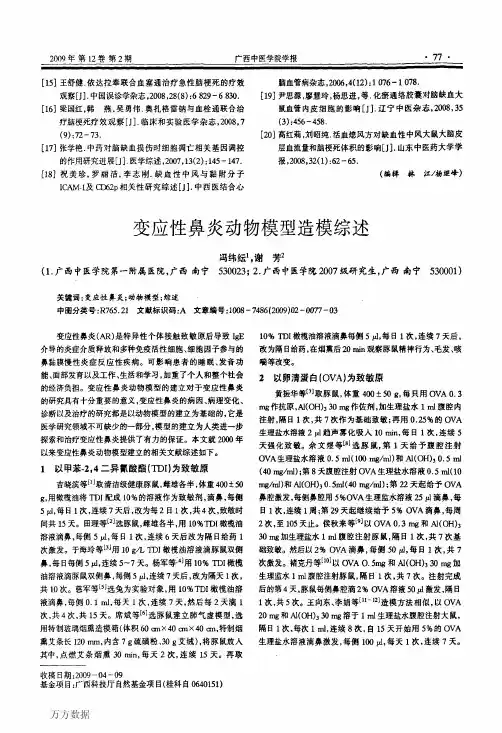
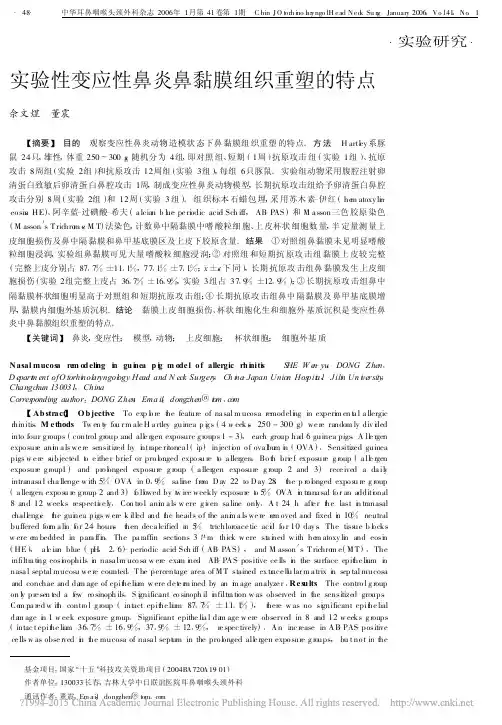
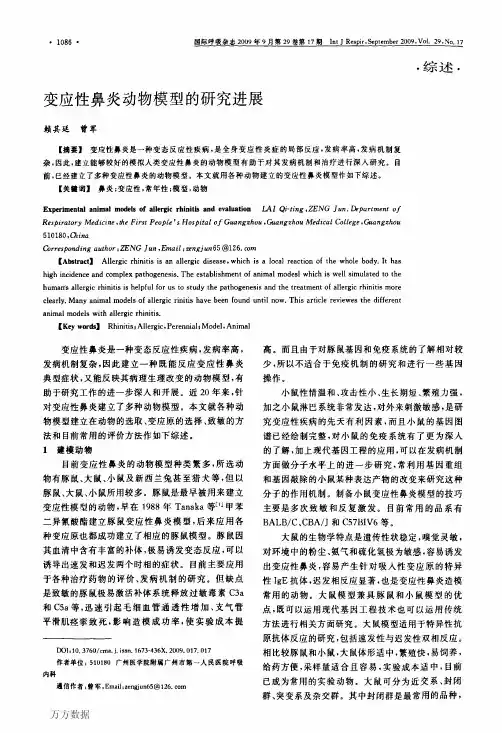
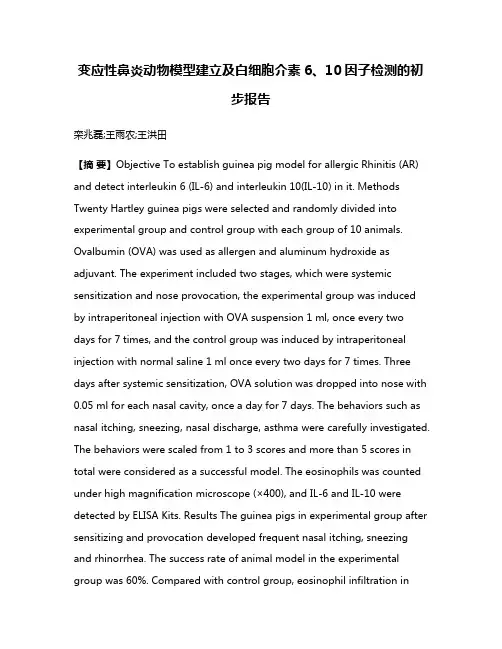
变应性鼻炎动物模型建立及白细胞介素6、10因子检测的初步报告栾兆磊;王雨农;王洪田【摘要】Objective To establish guinea pig model for allergic Rhinitis (AR) and detect interleukin 6 (IL-6) and interleukin 10(IL-10) in it. Methods Twenty Hartley guinea pigs were selected and randomly divided into experimental group and control group with each group of 10 animals. Ovalbumin (OVA) was used as allergen and aluminum hydroxide as adjuvant. The experiment included two stages, which were systemic sensitization and nose provocation, the experimental group was induced by intraperitoneal injection with OVA suspension 1 ml, once every two days for 7 times, and the control group was induced by intraperitoneal injection with normal saline 1 ml once every two days for 7 times. Three days after systemic sensitization, OVA solution was dropped into nose with 0.05 ml for each nasal cavity, once a day for 7 days. The behaviors such as nasal itching, sneezing, nasal discharge, asthma were carefully investigated. The behaviors were scaled from 1 to 3 scores and more than 5 scores in total were considered as a successful model. The eosinophils was counted under high magnification microscope (×400), and IL-6 and IL-10 were detected by ELISA Kits. Results The guinea pigs in experimental group after sensitizing and provocation developed frequent nasal itching, sneezing and rhinorrhea. The success rate of animal model in the experimental group was 60%. Compared with control group, eosinophil infiltration inexperimental group increased significantly (P < 0.05). The dead guinea pig in experimental group showed significant eosinophil infiltration in lung and bronchial mucosa compared to the control group seemingly like asthmatic inflammation. The experimental group had higher IL-6 level (185.41±9.57) ng/L, IL-10 level (99.97±12.71) ng/L than those in control group [IL-6 level (4.35±0.30) ng/L, IL-10 (4.45±0.31) ng/L] (P < 0.05, respectively). Conclusion The guinea pig model for AR is successfully established and lays the foundation for the following studies.%目的建立变应性鼻炎(allergic rhinitis,AR)豚鼠模型并检测白细胞介素6(interleukin 6,IL-6)和白细胞介素10(interleukin 10,IL-10).方法选用20只Hartley豚鼠,实验组和对照组各10只,随机分配.卵清蛋白(ovalbumin,OVA)作为致敏原,氢氧化铝作为佐剂.分两个阶段进行实验,第一阶段全身致敏,第二阶段鼻部激发.实验组OVA混悬液1 ml 腹腔注射,隔日1次,共7次;对照组0.9%氯化钠注射液1 ml腹腔注射.全身致敏后隔3 d用OVA溶液滴鼻,每侧鼻腔0.05 ml,1次/d,连续7 d;对照组用0.9%氯化钠注射液滴鼻.观察鼻痒(挠鼻)、喷嚏、清涕、哮喘等行为,用1~3分对四项行为评分,总分5分以上判定造模成功.高倍病理显微镜下计数嗜酸性粒细胞,用试剂盒检测黏膜组织中IL-6和IL-10.结果实验组豚鼠被致敏和激发后,频繁出现鼻痒(挠鼻)、喷嚏、清涕等行为,实验组造模成功率60%,实验组较对照组鼻黏膜嗜酸性粒细胞浸润明显增多(P<0.05).实验组死亡1只,其肺组织以及支气管黏膜较对照组嗜酸性粒细胞浸润明显.实验组豚鼠鼻黏膜组织IL-6水平为(185.41±9.57)ng/L,IL-10水平为(99.97±12.71)ng/L,较对照组IL-6水平(4.35±0.30)ng/L、IL-10水平(4.45±0.31)ng/L明显增高(P均<0.05).结论 AR豚鼠模型成功建立,为后续研究奠定了基础.【期刊名称】《解放军医学院学报》【年(卷),期】2017(038)004【总页数】4页(P333-336)【关键词】变应性鼻炎;动物模型;豚鼠;白细胞介素6;白细胞介素10【作者】栾兆磊;王雨农;王洪田【作者单位】解放军总医院耳鼻咽喉头颈外科,耳鼻咽喉研究所,北京 100853;解放军总医院耳鼻咽喉头颈外科,耳鼻咽喉研究所,北京 100853;解放军总医院耳鼻咽喉头颈外科,耳鼻咽喉研究所,北京 100853【正文语种】中文【中图分类】R765.21变应性鼻炎(allergic rhinitis,AR)是特异性个体接触变应原后主要由IgE介导的鼻黏膜的过敏性炎性反应疾病,常见症状是鼻痒、喷嚏、清涕、鼻塞[1]。
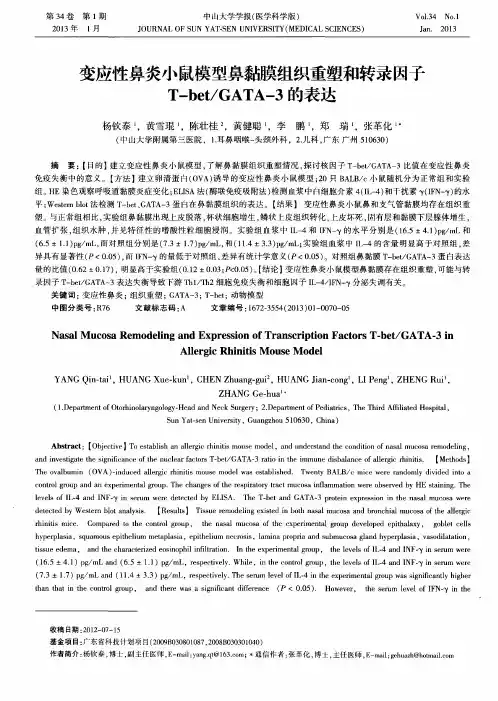
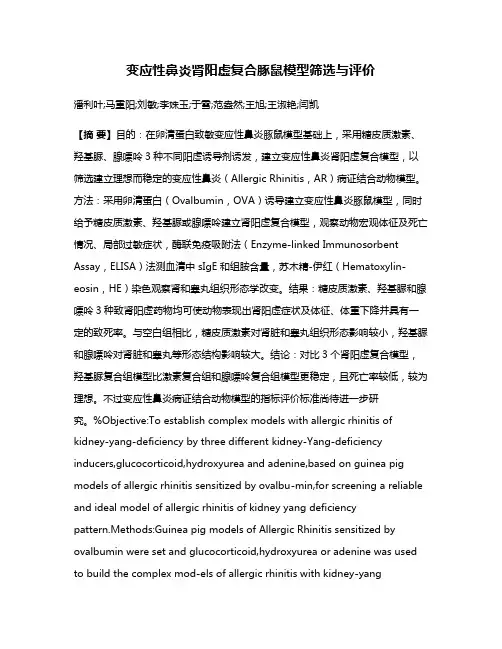
变应性鼻炎肾阳虚复合豚鼠模型筛选与评价潘利叶;马重阳;刘敏;李姝玉;于雪;范盎然;王旭;王淑艳;闫凯【摘要】目的:在卵清蛋白致敏变应性鼻炎豚鼠模型基础上,采用糖皮质激素、羟基脲、腺嘌呤3种不同阳虚诱导剂诱发,建立变应性鼻炎肾阳虚复合模型,以筛选建立理想而稳定的变应性鼻炎(Allergic Rhinitis,AR)病证结合动物模型。
方法:采用卵清蛋白(Ovalbumin,OVA)诱导建立变应性鼻炎豚鼠模型,同时给予糖皮质激素、羟基脲或腺嘌呤建立肾阳虚复合模型,观察动物宏观体征及死亡情况、局部过敏症状,酶联免疫吸附法(Enzyme-linked Immunosorbent Assay,ELISA)法测血清中 sIgE 和组胺含量,苏木精-伊红(Hematoxylin-eosin,HE)染色观察肾和睾丸组织形态学改变。
结果:糖皮质激素、羟基脲和腺嘌呤3种致肾阳虚药物均可使动物表现出肾阳虚症状及体征、体重下降并具有一定的致死率。
与空白组相比,糖皮质激素对肾脏和睾丸组织形态影响较小,羟基脲和腺嘌呤对肾脏和睾丸等形态结构影响较大。
结论:对比3个肾阳虚复合模型,羟基脲复合组模型比激素复合组和腺嘌呤复合组模型更稳定,且死亡率较低,较为理想。
不过变应性鼻炎病证结合动物模型的指标评价标准尚待进一步研究。
%Objective:To establish complex models with allergic rhinitis of kidney-yang-deficiency by three different kidney-Yang-deficiency inducers,glucocorticoid,hydroxyurea and adenine,based on guinea pig models of allergic rhinitis sensitized by ovalbu-min,for screening a reliable and ideal model of allergic rhinitis of kidney yang deficiencypattern.Methods:Guinea pig models of Allergic Rhinitis sensitized by ovalbumin were set and glucocorticoid,hydroxyurea or adenine was used to build the complex mod-els of allergic rhinitis with kidney-yangdeficiency.The macro signs,death and partial allergy symptoms of animals were observed, the serum sIgE and histamine were tested by ELISA (enzyme-linked immunosorbent assay)and the morphology change of kidney and testis tissue were observed by HE (hematoxylin-eosin)staining.Results:Three different Yang deficiency inducers,glucocor-ticoid,hydroxyurea and adenine,could lead to kidney-yang-deficiency symptoms and signs,weight loss,and cause certain death. Compared with the control group,it is found the affection on morphology of glucocorticoid to kidney and testis tissue was little, while which of hydroxyurea and adenine were great.Conclusion:By comparison of three different complex models with allergic rhinitis of kidney-yang deficiency,the model induced by hydroxyurea was more stable and suitable with lower death rate.More re-searches should be conducted for the evaluation criteria of the allergic rhinitis animal model.【期刊名称】《世界中医药》【年(卷),期】2016(011)012【总页数】6页(P2741-2746)【关键词】变应性鼻炎;肾阳虚;糖皮质激素;羟基脲;腺嘌呤【作者】潘利叶;马重阳;刘敏;李姝玉;于雪;范盎然;王旭;王淑艳;闫凯【作者单位】北京中医药大学基础医学院,100029,北京;北京中医药大学基础医学院,100029,北京;北京中医药大学基础医学院,100029,北京;北京中医药大学基础医学院,100029,北京;北京中医药大学基础医学院,100029,北京;北京中医药大学基础医学院,100029,北京;北京中医药大学基础医学院,100029,北京;北京中医药大学基础医学院,100029,北京;北京中医药大学附属东方医院,100078,北京【正文语种】中文【中图分类】R285.5目前最常见的变应性鼻炎动物模型是通过OVA致敏再诱发诱导致敏豚鼠血清IgE效价升高,从而出现相应鼻部过敏症状。
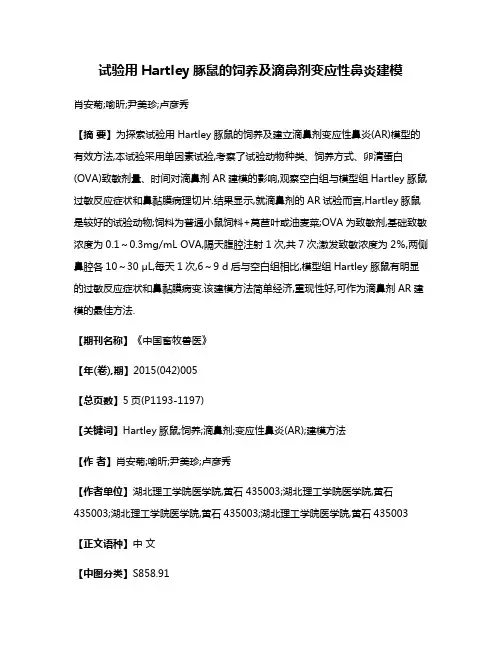
试验用Hartley豚鼠的饲养及滴鼻剂变应性鼻炎建模肖安菊;喻昕;尹美珍;卢彦秀【摘要】为探索试验用Hartley豚鼠的饲养及建立滴鼻剂变应性鼻炎(AR)模型的有效方法,本试验采用单因素试验,考察了试验动物种类、饲养方式、卵清蛋白(OVA)致敏剂量、时间对滴鼻剂AR建模的影响,观察空白组与模型组Hartley豚鼠过敏反应症状和鼻黏膜病理切片.结果显示,就滴鼻剂的AR试验而言,Hartley豚鼠是较好的试验动物;饲料为普通小鼠饲料+莴苣叶或油麦菜;OVA为致敏剂,基础致敏浓度为0.1~0.3mg/mL OVA,隔天腹腔注射1次,共7次;激发致敏浓度为2%,两侧鼻腔各10~30 μL,每天1次,6~9 d后与空白组相比,模型组Hartley豚鼠有明显的过敏反应症状和鼻黏膜病变.该建模方法简单经济,重现性好,可作为滴鼻剂AR建模的最佳方法.【期刊名称】《中国畜牧兽医》【年(卷),期】2015(042)005【总页数】5页(P1193-1197)【关键词】Hartley豚鼠;饲养;滴鼻剂;变应性鼻炎(AR);建模方法【作者】肖安菊;喻昕;尹美珍;卢彦秀【作者单位】湖北理工学院医学院,黄石435003;湖北理工学院医学院,黄石435003;湖北理工学院医学院,黄石435003;湖北理工学院医学院,黄石435003【正文语种】中文【中图分类】S858.91变应性鼻炎(allergic rhinitis,AR)以频繁发作的喷嚏、过量的鼻分泌物和显著鼻塞等症状为临床特征[1],是临床上常见的多发病,可发生在任何年龄段。
近年来,AR 的发病率在全球范围内呈明显上升趋势,它不仅可以导致患者一系列的呼吸道并发症,也严重影响着患者的生活质量、学习和工作效率等。
目前,临床仍以药物消除症状为主要治疗方法,AR 模型的建立对于治疗AR 的药物研究具有十分重要的意义。
冯纬纭等[2]综述了2000 年以来AR建模的相关文献,虽然很详尽,但试验动物、致敏剂浓度、使用剂量各不相同,后续试验者在建立滴鼻剂AR 模型仍感到无所适从。
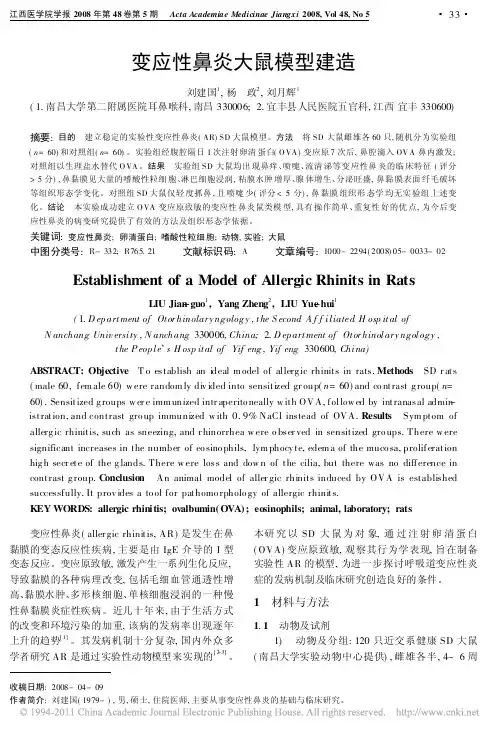
收稿日期:2008-04-09作者简介:刘建国(1979-),男,硕士,住院医师,主要从事变应性鼻炎的基础与临床研究。
变应性鼻炎大鼠模型建造刘建国1,杨 政2,刘月辉1(1.南昌大学第二附属医院耳鼻喉科,南昌330006; 2.宜丰县人民医院五官科,江西宜丰330600)摘要:目的 建立稳定的实验性变应性鼻炎(AR)SD 大鼠模型。
方法 将SD 大鼠雌雄各60只,随机分为实验组(n =60)和对照组(n =60)。
实验组经腹腔隔日1次注射卵清蛋白(O VA )变应原7次后,鼻腔滴入OV A 鼻内激发;对照组以生理盐水替代O VA 。
结果 实验组SD 大鼠均出现鼻痒、喷嚏、流清涕等变应性鼻炎的临床特征(评分>5分),鼻黏膜见大量的嗜酸性粒细胞、淋巴细胞浸润,粘膜水肿增厚、腺体增生、分泌旺盛,鼻黏膜表面纤毛破坏等组织形态学变化。
对照组SD 大鼠仅轻度抓鼻,且喷嚏少(评分<5分),鼻黏膜组织形态学均无实验组上述变化。
结论 本实验成功建立O VA 变应原致敏的变应性鼻炎鼠类模型,具有操作简单、重复性好的优点,为今后变应性鼻炎的病变研究提供了有效的方法及组织形态学依据。
关键词:变应性鼻炎;卵清蛋白;嗜酸性粒细胞;动物,实验;大鼠中图分类号:R-332;R765.21 文献标识码:A 文章编号:1000-2294(2008)05-0033-02Establishment of a Model of Allergic Rhinits in RatsLIU Jian -guo 1,Yang Zheng 2,LIU Yue -hui 1(1.D ep artment of Otor hinolary ngology ,the S econd A f f iliated H osp ital of N anchang Univ ersity ,N anchang 330006,China;2.D ep artment of Otor hinolary ngology ,the P eop le s H osp ital of Yif eng ,Yif eng 330600,China)ABSTRAC T:Objective T o establish an ideal m odel of allerg ic rhinits in rats.Methods SD r ats (male 60,fem ale 60)w ere random ly div ided into sensitized gr oup(n =60)and co ntrast g roup(n =60).Sensitized g roups w er e imm unized intr aperito neally w ith OVA,follow ed by intranasal admin -istration,and contrast gro up immunized w ith 0.9%NaCl instead of OVA.Results Sym ptom of allerg ic rhinitis,such as sneezing,and r hinorrhea w ere o bser ved in sensitized gro ups.There w ere significant increases in the number of eo sino phils,lym phocy te,edem a of the muco sa,proliferation hig h secr ete of the g lands.There w ere loss and dow n of the cilia,but there was no difference in contrast g roup.C onclusion An animal model of aller gic rhinits induced by OVA is established successfully.It prov ides a to ol for pathomo rpholo gy of allergic rhinits.KEY WORDS:allergic rhinitis;ovalbumin(OVA);eosinophils;animal,laboratory;rats 变应性鼻炎(aller gic rhinitis,AR)是发生在鼻黏膜的变态反应性疾病,主要是由IgE 介导的I 型变态反应。
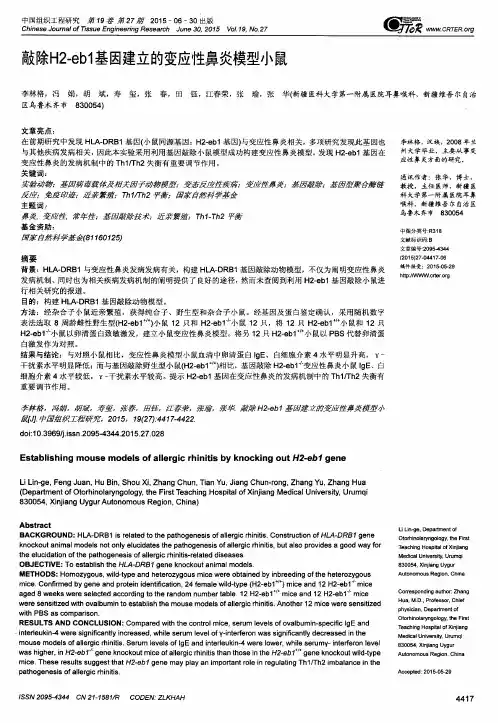
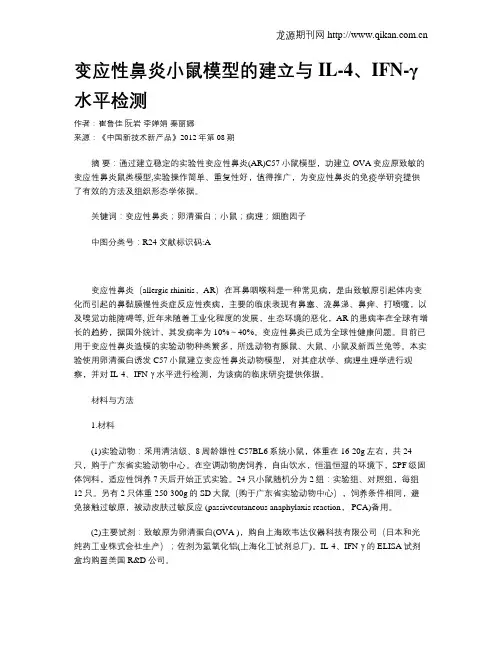
变应性鼻炎小鼠模型的建立与IL-4、IFN-γ水平检测作者:崔鲁佳阮岩李婵娟秦丽娜来源:《中国新技术新产品》2012年第08期摘要:通过建立稳定的实验性变应性鼻炎(AR)C57小鼠模型,功建立OVA变应原致敏的变应性鼻炎鼠类模型,实验操作简单、重复性好,值得推广,为变应性鼻炎的免疫学研究提供了有效的方法及组织形态学依据。
关键词:变应性鼻炎;卵清蛋白;小鼠;病理;细胞因子中图分类号:R24 文献标识码:A变应性鼻炎(allergic rhinitis,AR)在耳鼻咽喉科是一种常见病,是由致敏原引起体内变化而引起的鼻黏膜慢性炎症反应性疾病,主要的临床表现有鼻塞、流鼻涕、鼻痒、打喷嚏,以及嗅觉功能障碍等, 近年来随着工业化程度的发展,生态环境的恶化,AR 的患病率在全球有增长的趋势,据国外统计,其发病率为10%~40%。
变应性鼻炎已成为全球性健康问题。
目前已用于变应性鼻炎造模的实验动物种类繁多,所选动物有豚鼠、大鼠、小鼠及新西兰兔等。
本实验使用卵清蛋白诱发C57小鼠建立变应性鼻炎动物模型,对其症状学、病理生理学进行观察,并对IL-4、IFN-γ水平进行检测,为该病的临床研究提供依据。
材料与方法1.材料(1)实验动物:采用清洁级、8周龄雄性C57BL6系统小鼠,体重在16-20g左右,共24只,购于广东省实验动物中心。
在空调动物房饲养,自由饮水,恒温恒湿的环境下,SPF级固体饲料,适应性饲养7天后开始正式实验。
24只小鼠随机分为2组:实验组、对照组,每组12只。
另有2只体重250-300g的SD大鼠(购于广东省实验动物中心),饲养条件相同,避免接触过敏原,被动皮肤过敏反应 (passivecutaneous anaphylaxis reaction, PCA)备用。
(2)主要试剂:致敏原为卵清蛋白(OVA ),购自上海欧韦达仪器科技有限公司(日本和光纯药工业株式会社生产);佐剂为氢氧化铝(上海化工试剂总厂)。
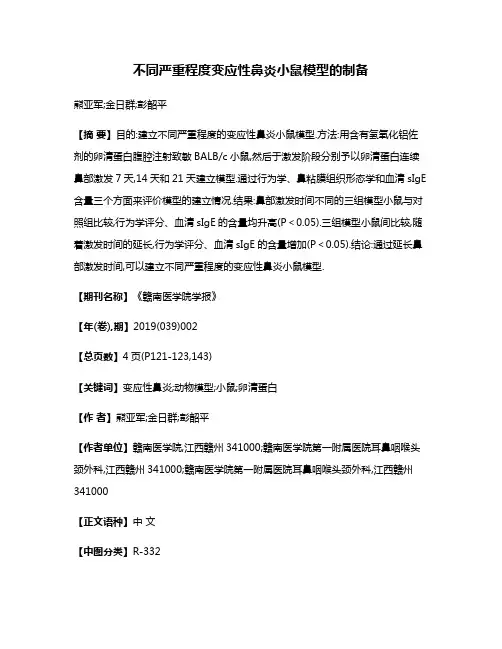
不同严重程度变应性鼻炎小鼠模型的制备熊亚军;金日群;彭韶平【摘要】目的:建立不同严重程度的变应性鼻炎小鼠模型.方法:用含有氢氧化铝佐剂的卵清蛋白腹腔注射致敏BALB/c小鼠,然后于激发阶段分别予以卵清蛋白连续鼻部激发7天,14天和21天建立模型.通过行为学、鼻粘膜组织形态学和血清sIgE 含量三个方面来评价模型的建立情况.结果:鼻部激发时间不同的三组模型小鼠与对照组比较,行为学评分、血清sIgE的含量均升高(P<0.05).三组模型小鼠间比较,随着激发时间的延长,行为学评分、血清sIgE的含量增加(P<0.05).结论:通过延长鼻部激发时间,可以建立不同严重程度的变应性鼻炎小鼠模型.【期刊名称】《赣南医学院学报》【年(卷),期】2019(039)002【总页数】4页(P121-123,143)【关键词】变应性鼻炎;动物模型;小鼠;卵清蛋白【作者】熊亚军;金日群;彭韶平【作者单位】赣南医学院,江西赣州341000;赣南医学院第一附属医院耳鼻咽喉头颈外科,江西赣州341000;赣南医学院第一附属医院耳鼻咽喉头颈外科,江西赣州341000【正文语种】中文【中图分类】R-332变应性鼻炎(allergic rhinitis,AR)作为一种危害人类健康和生活质量的全球性问题,已影响世界人口总数的10%~40%,且有逐年增加的趋势[1]。
到目前为止,AR仍不能被完全治愈,根本原因在于其发病机制复杂多样,包括遗传因素、免疫因素、环境因素等。
为了进一步深入了解AR的发病机制,寻找更好的治疗方案,国内外科研工作者们对于AR的研究从未停歇。
但是,由于受到研究对象的限制,很多研究不能直接在人体内进行,所以动物模型的制备就成了研究AR的一种必不可少的手段。
AR的临床分类方法有很多种,包括按变应原的类别、症状出现的时间、疾病的严重程度[2]等,而目前尚缺乏不同严重程度的AR动物模型的制备,因此,我们在基础致敏后,通过延长鼻部激发的时间来探索不同严重程度AR动物模型的制备。
豚鼠和新西兰兔变应性鼻炎模型建立及比较张丽1,杜经纬2,王丽洪2,谭毅3,龚晓波1,江鹏1,王智彪1(1.重庆医科大学生物医学工程系、重庆市生物医学工程学重点实验室、重庆市超声医学工程重点实验室-省部共建国家重点实验室培育基地,重庆400016;2.重庆医科大学附属第一医院耳鼻咽喉科,重庆400016;3.重庆医科大学实验动物中心,重庆400016)【摘要】目的:旨在比较不同动物在不同剂量致敏原诱导下形成变应性鼻炎模型的特点。
方法:采用甲苯-2,4-二异氰酸酯(Toluene-2,4-diisocyanate ,TDI )致敏豚鼠和新西兰兔制作变应性鼻炎动物模型,在豚鼠和新西兰兔组中又各自使用高低两种TDI 剂量。
记录建模过程中动物症状体征评分,典型表现;末次激发后行鼻黏膜组织病理学检查及组胺含量测定;记录动物死亡率和建模成功率;对死亡动物行呼吸道解剖和组织病理学检查,探索死亡原因。
结果:豚鼠和新西兰兔均能在TDI 诱导下形成变应性鼻炎典型症状体征,模型组动物鼻黏膜见大量以嗜酸性粒细胞为主炎症细胞浸润且组胺含量明显增高(与空白对照组比较P <0.01)。
但不同动物之间,以及相同动物在不同给药剂量下,其症状体征出现的时间、典型表现、鼻黏膜嗜酸性粒细胞浸润程度、鼻黏膜组胺含量高低、建模死亡率、成功率等均有较大差异。
动物死亡原因与药物剂量和变态反应均有一定关系。
结论:豚鼠和新西兰兔在不同药物剂量下均可成功建模,但成模特点差异较大,应根据研究目的不同选取所需模型。
【关键词】变应性鼻炎;动物模型;豚鼠;新西兰兔【中图图书分类法分类号】R765.21【文献标识码】A【收稿日期】2008-12-25Comparison of allergic rhinitis animal models in guinea pigs and new zealandrabbitsZHANG Li ,et al(Department of Otolaryngology ,the First Affiliated Hospital ,Chongqing Medical University )【Abstract 】Objective :To compare the characteristics of allergic rhinitis animal models in two different animals (Guinea pigs and New Zealand rabbits )induced with various doses of toluene-2,4-Diisocyanate (TDI ).Methods :Low dose and high dose of TDI olive oil solution was used as sensitizer to establish models of Guinea pigs and New Zealand rabbits.The typical symptoms and sings of Guinea pigs and New Zealand rabbits were respectively scored during modeling.After the last challenge ,nasal mucosa of Guinea pigs and New Zealand rabbits were histopathologically examined and the level of histamine in nasal mucosa was measured by spectrofluorometer.The mortality rates and model success rates were record.Respiratory tracts of dead animals were dissected and histopathologically examined to find out the causes of their death.Results :Compared with control groups ,all the Guinea pigs and New Zealand rabbits in model groups got typical symptoms and sings of allergic rhinitis.Histopathology examination of nasal mucosa showed eosinophile cells infiltrating obviously.The levels of histamine in nasal mucosa were highly increased (P <0.01).However ,between Guinea pigs and New Zealand rabbits ,even the same animal specie but treated with different doses of TDI demonstrated obviously different results during modeling ,including the time of symptoms and signs to appear ,the most typical symptoms and signs ,the degree of invasion of eosinophile cells ,the level of histamine in nasal mucosa,the mortality rates and success rates.Dissection of the dead animals shows the cause of death may be connected with the drug doses and allergy.Conclusion :Allergic rhinitis animal models induced with two different doses of TDI in different animals have different characteristics.The selection of animal models should adapt to research purposes.【Key words 】Allergic rhinitis ;Animal models ;Guinea pigs ;New Zealand rabbits变应性鼻炎是耳鼻喉科常见病,探索其发病机制和治疗方法均需质量稳定的动物模型。
樟树花粉致变应性鼻炎小鼠模型的建立张美幸;谢亦璘;冷蓓峥;乔中东;王莲芸;闫晓梅【摘要】为了探讨樟树花粉的致敏性,在樟树花粉的盛花季节采摘、分离和纯化花粉,提取樟树花粉蛋白质,对10只BALB/c小鼠进行腹腔和皮下多点注射免疫,并滴鼻激发,观察小鼠过敏性鼻炎的症状,检测鼻分泌物涂片和鼻部组织切片以及血清IgE值.结果发现,7只致敏组小鼠出现了频繁抓鼻、打喷嚏等过敏性鼻炎症状(评分>5分);致敏组小鼠的鼻分泌物涂片中嗜酸性粒细胞明显增多,鼻部组织切片显示鼻腔黏膜层明显充血水肿,白细胞浸润;致敏组小鼠血清中IgE含量明显上升(P<0.05).因此,建立了樟树花粉致过敏性鼻炎小鼠模型,为樟树花粉的致敏性提供了实验依据.【期刊名称】《实验室研究与探索》【年(卷),期】2015(034)009【总页数】5页(P4-7,49)【关键词】樟树花粉;变应性鼻炎;小鼠模型;过敏【作者】张美幸;谢亦璘;冷蓓峥;乔中东;王莲芸;闫晓梅【作者单位】上海交通大学生命科学技术学院,上海200240;上海交通大学生命科学技术学院,上海200240;上海市第五人民医院呼吸科,上海200240;上海交通大学生命科学技术学院,上海200240;上海交通大学生命科学技术学院,上海200240;上海交通大学生命科学技术学院,上海200240【正文语种】中文【中图分类】R392.30 引言植物类变应原有吸入性、食入性和接触性3 种,其中吸入性植物变应原主要是空气中广泛存在的花粉。
在I 型变态反应疾病患者中,大约有40%的病人与花粉的接触有关[1]。
樟树(Cinnamomum camphora (L.)Presl.)为樟科樟属的常绿大乔木,广泛分布于中国长江以南各地。
樟树花期为5 月,每年春季大量散发极其微小的花粉颗粒,可能是我国南方地区的一种过敏原[2]。
在上海地区,樟树和法国梧桐已经成为城市的两种主要行道树。
通过对上海市西南部郊区空气中气传花粉的调查,发现樟树花粉是当地春季空气中飘散的优势花粉[3]。
敲除H2-eb1基因建立的变应性鼻炎模型小鼠李林格;冯娟;胡斌;寿玺;张春;田钰;江春荣;张瑜;张华【摘要】背景:HLA-DRB1与变应性鼻炎发病发病有关,构建HLA-DRB1基因敲除动物模型,不仅为阐明变应性鼻炎发病机制、同时也为相关疾病发病机制的阐明提供了良好的途径,然而未查阅到利用H2-eb1基因敲除小鼠进行相关研究的报道。
目的:构建HLA-DRB1基因敲除动物模型。
方法:经杂合子小鼠近亲繁殖,获得纯合子、野生型和杂合子小鼠。
经基因及蛋白鉴定确认,采用随机数字表法选取8周龄雌性野生型(H2-eb1+/+)小鼠12只和 H2-eb1-/-小鼠12只,将12只H2-eb1+/+小鼠和12只H2-eb1-/-小鼠以卵清蛋白致敏激发,建立小鼠变应性鼻炎模型。
将另12只H2-eb1+/+小鼠以PBS代替卵清蛋白激发作为对照。
结果与结论:与对照小鼠相比,变应性鼻炎模型小鼠血清中卵清蛋白IgE、白细胞介素4水平明显升高,γ-干扰素水平明显降低;而与基因敲除野生型小鼠(H2-eb1+/+)相比,基因敲除H2-eb1-/-变应性鼻炎小鼠IgE、白细胞介素4水平较低,γ-干扰素水平较高。
提示H2-eb1基因在变应性鼻炎的发病机制中的Th1/Th2失衡有重要调节作用。
%BACKGROUND:HLA-DRB1 is related to the pathogenesis of alergic rhinitis. Construction ofHLA-DRB1 gene knockout animal modelsnot only elucidates the pathogenesis of alergic rhinitis, but also provides a good way for the elucidation of the pathogenesis of alergic rhinitis-related diseases. OBJECTIVE:To establish the HLA-DRB1gene knockout animal models. METHODS:Homozygous, wild-type and heterozygous mice were obtained by inbreeding of the heterozygous mice. Confirmed by gene and protein identification, 24 female wild-type (H2-eb1+/+) mice and 12 H2-eb1-/-mice aged 8 weeks were selected according to the random numbertable. 12 H2-eb1+/+ mice and 12 H2-eb1-/- mice were sensitized with ovalbumin to establish the mouse models of alergic rhinitis. Another 12 mice were sensitized with PBS as comparison. RESULTS AND CONCLUSION:Compared with the control mice, serum levels of ovalbumin-specific IgE and interleukin-4 were significantly increased, while serum level ofγ-interferon was significantly decreased in the mouse models of alergic rhinitis. Serum levels of IgE and interleukin-4 were lower, while serumγ- interferon level was higher, inH2-eb1-/-gene knockout mice of alergic rhinitis than those in the H2-eb1+/+ gene knockout wild-type mice. These results suggest thatH2-eb1 gene may play an important role in regulating Th1/Th2 imbalance in the pathogenesis of alergic rhinitis.【期刊名称】《中国组织工程研究》【年(卷),期】2015(000)027【总页数】6页(P4417-4422)【关键词】实验动物;基因病毒载体及相关因子动物模型;变态反应性疾病;变应性鼻炎;基因敲除;基因型聚合酶链反应;免疫印迹;近亲繁殖;Th1/Th2平衡;国家自然科学基金【作者】李林格;冯娟;胡斌;寿玺;张春;田钰;江春荣;张瑜;张华【作者单位】新疆医科大学第一附属医院耳鼻喉科,新疆维吾尔自治区乌鲁木齐市830054;新疆医科大学第一附属医院耳鼻喉科,新疆维吾尔自治区乌鲁木齐市830054;新疆医科大学第一附属医院耳鼻喉科,新疆维吾尔自治区乌鲁木齐市830054;新疆医科大学第一附属医院耳鼻喉科,新疆维吾尔自治区乌鲁木齐市830054;新疆医科大学第一附属医院耳鼻喉科,新疆维吾尔自治区乌鲁木齐市830054;新疆医科大学第一附属医院耳鼻喉科,新疆维吾尔自治区乌鲁木齐市830054;新疆医科大学第一附属医院耳鼻喉科,新疆维吾尔自治区乌鲁木齐市830054;新疆医科大学第一附属医院耳鼻喉科,新疆维吾尔自治区乌鲁木齐市830054;新疆医科大学第一附属医院耳鼻喉科,新疆维吾尔自治区乌鲁木齐市830054【正文语种】中文【中图分类】R318文章亮点:在前期研究中发现HLA-DRB1基因(小鼠同源基因:H2-eb1基因)与变应性鼻炎相关,多项研究发现此基因也与其他疾病发病相关,因此本实验采用利用基因敲除小鼠模型成功构建变应性鼻炎模型,发现H2-eb1基因在变应性鼻炎的发病机制中的Th1/Th2失衡有重要调节作用。
变应性鼻炎小鼠模型血清代谢组学研究摘要:变应性鼻炎(AR)是一种常见的呼吸道疾病,其发病机制复杂多样。
本研究利用小鼠模型,采用血清代谢组学技术研究AR的血清代谢物变化。
结果发现,AR小鼠血清中谷氨酰胺、乳酸、精氨酸等代谢物浓度明显高于对照组。
此外,AR小鼠血清中甘油三酯、低密度脂蛋白等脂质类代谢物也有显著的变化。
这些代谢物的变化与AR的发病、病理生理机制有关。
因此,本研究为AR的诊断和治疗提供了新的思路和基础研究支持。
关键词:变应性鼻炎;小鼠模型;血清代谢组学;代谢物Introduction:变应性鼻炎(AR)是一种常见的呼吸道疾病,其发病机制复杂多样,目前尚缺乏全面的疾病诊治方法。
血清代谢组学技术可以全面分析生物体内代谢物的变化,为疾病的发病机制和诊治提供有力的支持。
本研究旨在利用小鼠模型,探究AR的血清代谢物变化及其与疾病的关系。
Methods:选取12只BALB/c小鼠随机分为AR组和对照组,每组6只。
AR小鼠通过鼻腔喷雾蛋白质卵白酶(OVA)进行模拟AR,对照组则喷雾脱敏剂。
经过24h、48h、72h的干预后,取小鼠外围血浆进行代谢组学分析。
采用得到的代谢物谱与数据库匹配,确定代谢物名称、分子式、分子量等信息,并分析AR组与对照组的代谢物谱差异。
Results:通过代谢物分析发现,AR小鼠血清中谷氨酰胺、乳酸、精氨酸等代谢物浓度高于对照组。
此外,AR小鼠血清中甘油三酯、低密度脂蛋白等脂质类代谢物也有显著的变化。
这些代谢物的变化与AR的发病、病理生理机制有关。
例如,谷氨酰胺可参与调节氮代谢和免疫炎症反应,而乳酸则与呼吸性代谢的变化密切相关。
Conclusion:血清代谢组学技术可以全面、高通量地分析代谢物的变化,为疾病的发病机制和诊治提供基础研究支持。
本研究利用小鼠模型,探究AR的血清代谢物变化,发现谷氨酰胺、乳酸、精氨酸等代谢物浓度高于对照组,AR小鼠血清中甘油三酯、低密度脂蛋白等脂质类代谢物也有显著变化。
利拉鲁肽对变应性鼻炎小鼠模型的治疗作用孔德弟;王俊;向明亮;孙星梅;王士礼【摘要】目的·探究利拉鲁肽腹腔注射能否改善小鼠变应性鼻炎(allergic rhinitis,AR)的炎症状态,为AR提供新的治疗选择.方法·选取SPF级BALB/c小鼠18只,采用随机数字表法分为正常对照组、AR组、治疗组.利用卵清蛋白(ovalbumin,OVA)和氢氧化铝建立AR小鼠模型(包括AR组和治疗组,正常对照组用生理盐水代替),治疗组行利拉鲁肽腹腔注射(另2组用生理盐水代替).观察小鼠在利拉鲁肽干预后打喷嚏和挠鼻次数的改变,检测小鼠鼻黏膜内嗜酸性粒细胞浸润数、杯状细胞增生情况以及黏膜形态的变化.酶联免疫吸附实验分别检测小鼠血清中OVA-specific IgE (OVA-sIgE)、IL-4和IL-5的浓度.结果·对照组鼻黏膜嗜酸性粒细胞浸润少见,偶见杯状细胞增生;AR组杯状细胞增生明显,大量嗜酸性粒细胞浸润,黏膜增厚.AR组杯状细胞增生、嗜酸性粒细胞数和黏膜厚度较对照组显著增加(均P<0.05),AR组小鼠的挠鼻及喷嚏数均显著高于对照组(均P<0.05),而治疗组小鼠上述症状较AR组均减轻(均P<0.05).AR组小鼠血清中OVA-sIgE、IL-4和IL-5的浓度显著高于对照组(均P<0.05),治疗组以上指标均低于AR组(均P<0.05).结论·利拉鲁肽腹腔注射可以有效改善小鼠AR的症状和炎症程度,有可能成为治疗AR新的研究方向.【期刊名称】《上海交通大学学报(医学版)》【年(卷),期】2019(039)005【总页数】7页(P487-493)【关键词】小鼠模型;变应性鼻炎;嗜酸性粒细胞;胰高血糖素样肽-1【作者】孔德弟;王俊;向明亮;孙星梅;王士礼【作者单位】上海交通大学医学院附属瑞金医院耳鼻咽喉科,上海200025;上海交通大学医学院附属瑞金医院耳鼻咽喉科,上海200025;上海交通大学医学院附属瑞金医院耳鼻咽喉科,上海200025;上海交通大学医学院附属瑞金医院耳鼻咽喉科,上海200025;上海交通大学医学院附属瑞金医院耳鼻咽喉科,上海200025【正文语种】中文【中图分类】R593.1变应性鼻炎(allergic rhinitis,AR)又称过敏性鼻炎,是耳鼻咽喉科常见的疾病之一,是机体在变应原刺激后,发生的主要由免疫球蛋白 E (IgE)介导的鼻黏膜非感染性慢性炎症疾病,以鼻塞、阵发性喷嚏、瘙痒等为主要特征[1]。